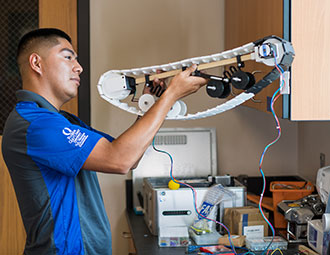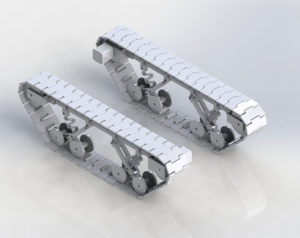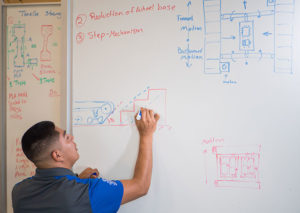Yesterday’s wheelchairs pale in comparison to today’s more sophisticated models, many now designed to meet the challenges of climbing stairs, taking a “hike” across rocky terrain, “strolling” down a beach or maneuvering through snow. But what about squeezing through narrow spaces? Or what about inventing a wheelchair that does it all?
Cesar Hernandez-Isidro (’20, Bioengineering) not only asked himself that question, he set about designing a type of all-terrain wheelchair that expands and contracts, a potentially ground-breaking advance in the marketplace.
“My idea is to design a wheelchair that does it all based on what the user needs at any moment,” he said.

A successful design would mean that a person would only need to purchase one wheelchair, a boon for consumers since wheelchairs tend to be expensive.
To accomplish his goal, Hernandez-Isidro said, compromise is the name of the game. Some wheelchairs, especially those designed specifically for outdoor use, sit on a tank-like belt that rolls the chair to and fro. But, he said, the belt is bulky and, therefore, so is the chair. He researched existing climbing wheelchair capabilities and decided to design a chair using the tank-like belt design for stability, control and versatility, but to construct a slimmed-down base that has the capability to contract to the width of the user’s body. A lofty goal, and one that requires mechanical and technical skill, laser focus, a good deal of patience and lots of time.

Hernandez-Isidro’s research began last semester as an Honors College project when Derek Lura, assistant professor in bioengineering, introduced him to Jennifer Lee, who was referred to FGCU during a fitting for her new wheelchair. Lee shared her daily struggles with Hernandez-Isidro, among them her inability to navigate through doorways in her home, given the width of her wheelchair. Her bedroom, too, presented a challenge as it is one step up, one step down, and her current wheelchair cannot navigate steps. “I can walk,” she said, “but not far. And I rent, so renovating the house is not an option. Cesar is trying to create something that will make my life easier. If successful, it will definitely change my life and the lives of many people.”
“A lot of my benchmarks are based off Jennifer’s needs,” said Hernandez-Isidro, who continues to meet with her at her home and at FGCU to discuss the progress.
“I’m very excited about all the possibilities,” Lee said. “We’ve even discussed the chances of my being able to go to the beach” something, she said, she has not been able to do for quite a while.

“This is still a relatively new project for our lab,” said Lura, “and Cesar is doing an excellent job as an undergraduate student working on a design of this complexity. For me, the result of the research is significantly less important than the skills students develop by working on the projects. They will have their entire careers to make a difference helping improve the health and well-being of the population. This is just one step on a life-long journey.”
When the spring semester ended, Hernandez-Isidro opted to continue his research throughout the summer.
“Dr. Lura has been invaluable to me,” he said, “advising me, sharing his knowledge as to how to build specific mechanisms, helping with supplies to build the prototype, which is now under way.”

After using 3-D modeling software to design the base, Hernandez-Isidro initiated the 3-D printing phase, a slow and meticulous process. “I’m focusing on the stair climbing aspect of my design,” he said, “and most of the base mechanism is complete.”
Once successfully tested, he will begin designing, prototyping and testing the contracting elements of the chair. And, like any innovation, should any aspect of the test fail, Hernandez-Isidro will, literally, be back to the drawing board.
His career goal is to work in the bio-mechatronics industry. “I’m interested in focusing on integrating electronic and mechanical devices to help patients regain mobility and independence, as a result of physical limitations caused through disease or accident.”